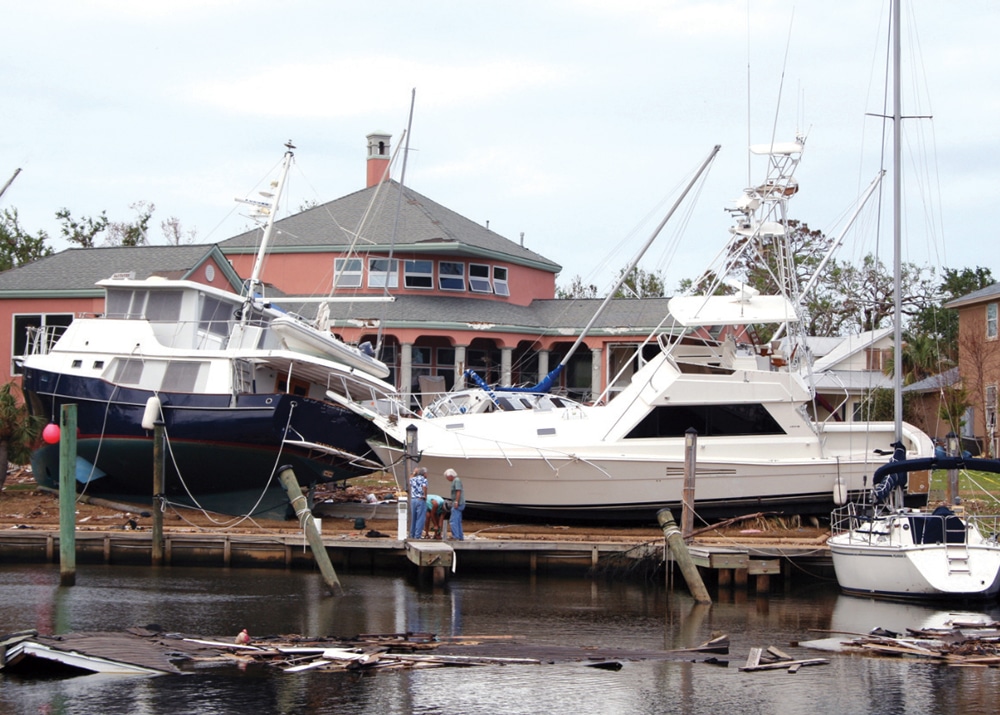
Bracing for the Storm
I’ve been through more hurricanes than I care to count; even one at sea. Through all, and with input from other well-weathered sources, I’ve come to realize three things: First, all storms need to be given the same weight. The “little” ones can carry an unexpected wallop. Second, hurricane preparation must be organized in advance, so it’s simple and quick. There are more important considerations, like family, when a storm threatens. And third, local topography, marina construction, and just plain luck all affect storm survivability, and can work to your advantage.
During Florida’s infamous 2004 season, the weakest storm, Hurricane Frances, did as much damage as the stronger Jeanne. “Frances lasted for 12 or 14 hours. It stalled right offshore,” says Mark Lavery, in charge of marina operations at Old Port Cove Marina and neighboring North Palm Beach Marina (www.opch.com). “A [category] three that [blows hard for] an hour probably wouldn’t be as bad.” The following year, Hurricane Wilma equaled the two previous storms combined, even though winds were forecast below hurricane strength on Florida’s east coast.
“People were thinking 40 or 50 mph winds at the [wall of the] eye, and 30 mph outside the eye. We’d just been through Frances and Jeanne, so that was no big deal,” says Jim Hunt, operator of a charter fleet that lay in the path of all three storms. Cold, dry air from the north eventually did weaken Wilma, but it first fired up powerful thunderstorms that spun around its giant eye like teeth on a saw. Boats that were ready fared fine, but those caught off-guard suffered significant damage.
Hunt says chafing gear was a big factor. For Lavery, tight spring lines were key at the fixed piers at Old Port Cove. “[When lines are loose] boats slingshot around in the slip and things start to break,” he says. “A piling breaks or you pull a cleat out, then it becomes a domino effect.” Fortunately, storm surge wasn’t a factor, with deep water and a straight coastline in this part of Florida.
Other locations are different. Hurricane Isabel weakened considerably as it came ashore in 2003, but tropical storm winds pushed water northward and piled it high along the shores of the narrowing Chesapeake Bay. “It wasn’t a wind event. The only thing we battled was the surge,” says Rob Simkins, general manager of Chesapeake Harbour Marina in Annapolis (www.chesapeakeharbour.com). Water rose to waist-deep above fixed docks— eight feet above normal. “If it was blowing 50 or 60 it would have been a real mess.” But Chesapeake Harbour is in an enclosed basin, surrounded by wind-buffering three-story townhomes and encircled with wave-attenuating riprap. Other marinas didn’t fare as well.
Boats at the protected Baltimore Inner Harbor Marine Center (www.baltimoreinnerharbormarinecenter.com) fared well during Isabel, but the surge came dangerously close to piling tops. “Another foot and the docks would have floated away,” says Guy Lambert, the assistant manager at the time. “Once the tide started down, we actually had to pry the docks back into place over the pilings.”
Pilings were adequate in Washington, D.C., where I weathered Isabel’s nine-foot storm tide, but the floating docks weren’t. I shackled lines to short lengths of chain around the pilings, so they were free to move up and down with the tide.
In Baltimore, a new marina with taller pilings has been engineered with storms in mind. And the trend is growing, making floating docks preferred hurricane moorings. “We moved boats into North Palm Beach Marina,” Lavery says. “We had zero damage to the marina and only minimal damage to boats.” Lavery credits this to the marina’s protected basin and surrounding buildings, and also the ability to tie boats tightly to stout floating docks so they couldn’t move in the wind. Old Port Cove Marina was recently rebuilt with floating docks engineered for its more exposed location— wide, heavy outer docks, anchored by long steel pilings, are guaranteed to withstand hurricane winds and seas while supporting a full complement of boats.
Then there’s luck. Hurricane Charley brought 150 mph winds—the first of Florida’s 2004 quadruple beating—and a half mile meant the difference between survivable damage and utter devastation. This mirrored Hurricane Andrew. “Houses on one side of the street came through with minimal damage while just across the street they were completely destroyed,” says Hunt, who weathered the 165 mph winds in Spanish Wells, Eleuthera. The odds of catching the worst of even these Category 4 and 5 storms was small.
“A wobble can save you,” Lavery says. “Do the best you can do in the time you’ve got, but when the hurricane starts, be somewhere safe. There isn’t a boat out there worth dying for.”
Hurricane Tips From the Experts
Make preparations at the start of the season, not when a storm threatens, and don’t rely on marina staff—they have enough to do.
1. Reduce windage. Five square yards of canvas generates 10 pounds of force in a 10-knot wind, and 1,000 pounds at 100 knots. Wrap exposed electronics with the clingy plastic wrap used by moving companies (the industrial version of kitchen plastic wrap) and weatherproof tape. —Mark Lavery, Old Port Cove Marina and North Palm Beach Marina in Palm Beach, Florida
2. The best chafing gear is fire hose, available for free from local fire stations. Rubber hose is better than plastic or vinyl. Take strain off all-chain anchor rodes with long nylon snubbers attached with chain hooks. —Jim Hunt, charter fleet operator
3. Prepare for days without power. Remove perishables and tie all battery banks together for bilge pumps. —Rob Simkins, general manager of Chesapeake Harbour Marina in Annapolis, Maryland
4. Long lines remain tighter as tides rise and fall. Bypass the closest cleat or piling for one farther away. Spread the load among parallel lines attached to multiple points on the boat and dock.








